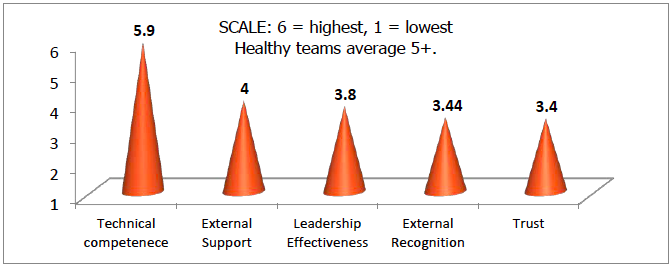Focus on Teaming
Challenge
A multi-national financial firm in a highly regulated environment depended heavily on its compliance team of 13 lawyers to guide them through all aspects of the project completion cycle, and that team had become dysfunctional. The team lead “Barbara” called 5 Dynamics because her group had splintered into a we/they mindset. Located four time zones apart, some teammates had stopped speaking and collaborating. She had made open communication a major emphasis and couldn’t understand why her group wasn’t improving. Barbara had heard from the company’s executive team that 5 Dynamics could catalyze rapid changes in group performance and wanted to learn more.
Action
5 Dynamics developed a three-part strategy: measure / meet / follow up. First, the teammates anonymously completed our team assessment, measuring the group’s view of its performance in terms of factors critical to their success. The lowest scores emerged in the areas of trust, external recognition, and leadership effectiveness. A subset of average scores appears below:

The survey revealed a deeply skewed team, self-evaluating at opposite ends of the spectrum on many items. The highest was technical competence; the lowest three were trust, external recognition, and leadership effectiveness also skewed toward extremes. In the composite of 5 Dynamics Energies, the team appears balanced, but just below the surface are two different factions comprising 10 people who have much different outlooks on the world. The teams’ scores appear below. Barbara’s inability to see “beyond her own Energies” contributed to her difficulty in knowing what was wrong and what to do about it.

A 5 Dynamics facilitator led a six-hour, in-person modified Fundamentals session which taught the group about their Energies and how to apply them to work together through the project completion cycle and with each other. Barbara learned how her own natural biases impeded her ability to understand and collaborate with her team. The team developed a highly effective, non-personal way of communicating about and sharing work. During the session, they developed practical behavioral norms in the form of individual commitments.
Results
One team member who had not spoken with Barbara in six months immediately asked to collaborate with her on mutual coaching. Barbara called the session “very constructive” and requested to continue working with 5 Dynamics to sustain the progress the team made. The two “groups” now consider themselves one team, and collaborate productively throughout the project completion cycle together despite (or perhaps because of) their differences. 5 Dynamics was next invited to work in the general counsel’s office.
It was fascinating to me, to become more aware of my work preferences (the assessment was spot-on), and it was interesting to see my colleagues in a new light. [The] enthusiasm and insights made it all very fun but also on a more serious note I am sure the discussions will help us start to communicate and work together more productively as a team.
— Executive Director